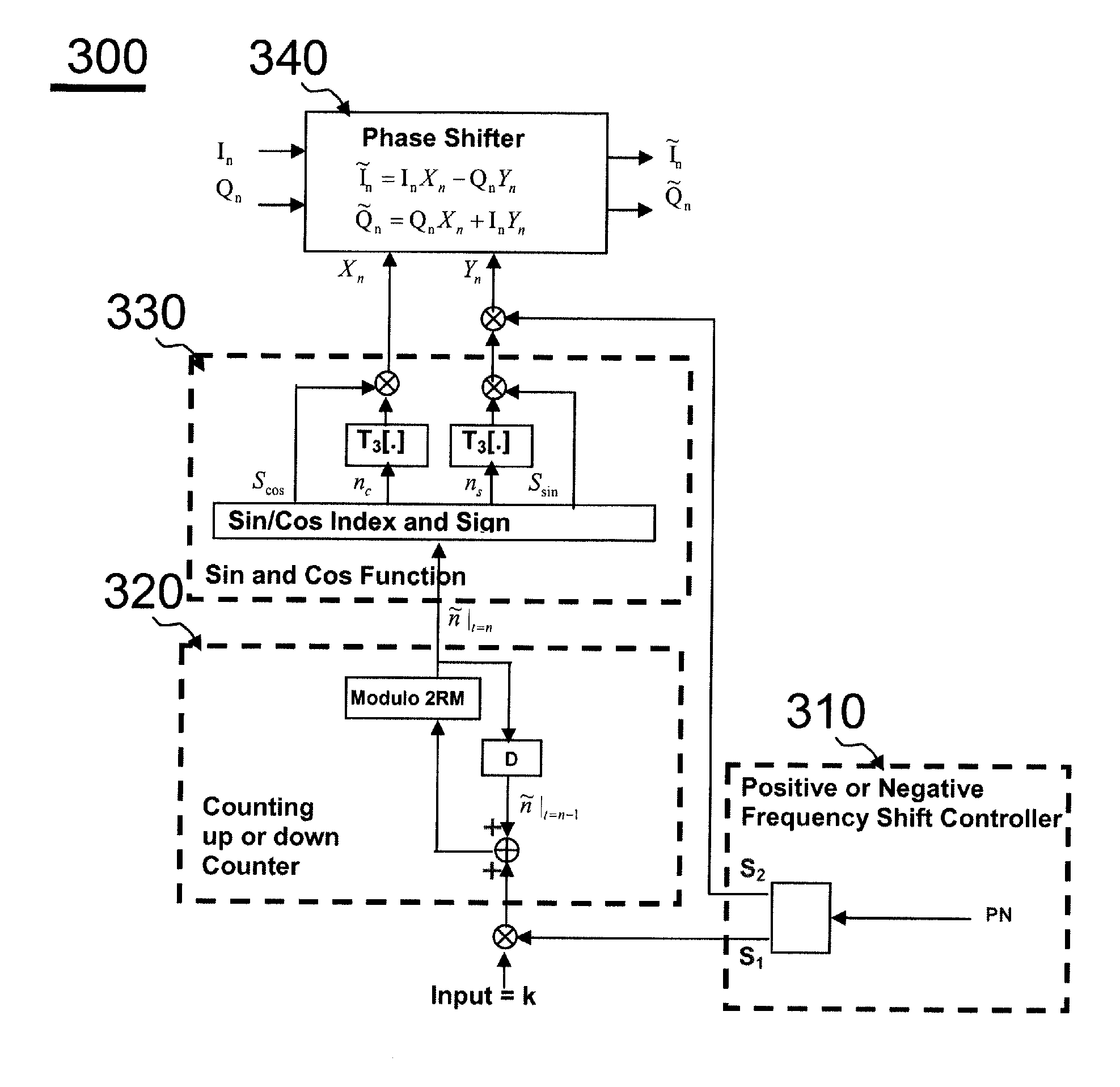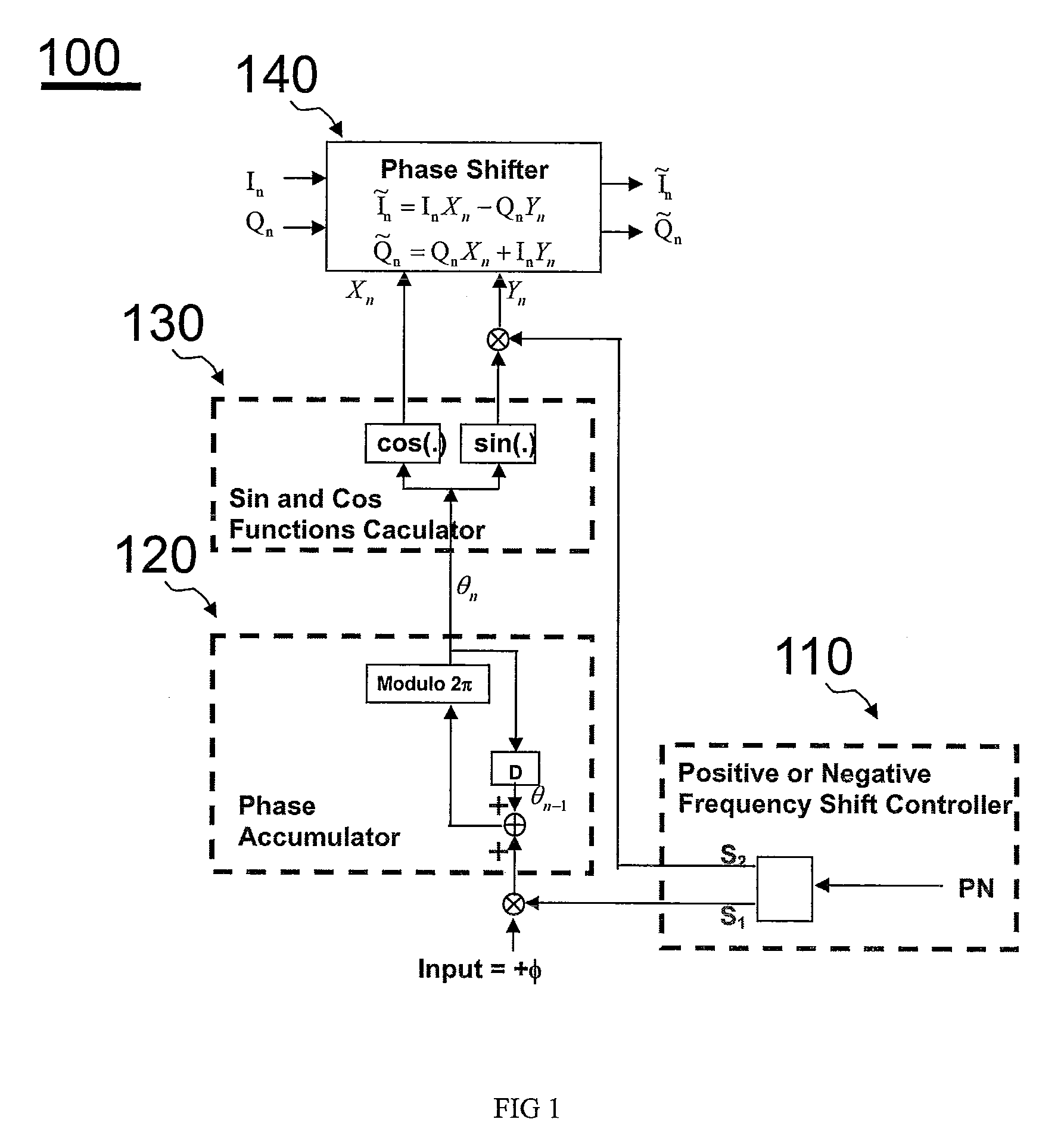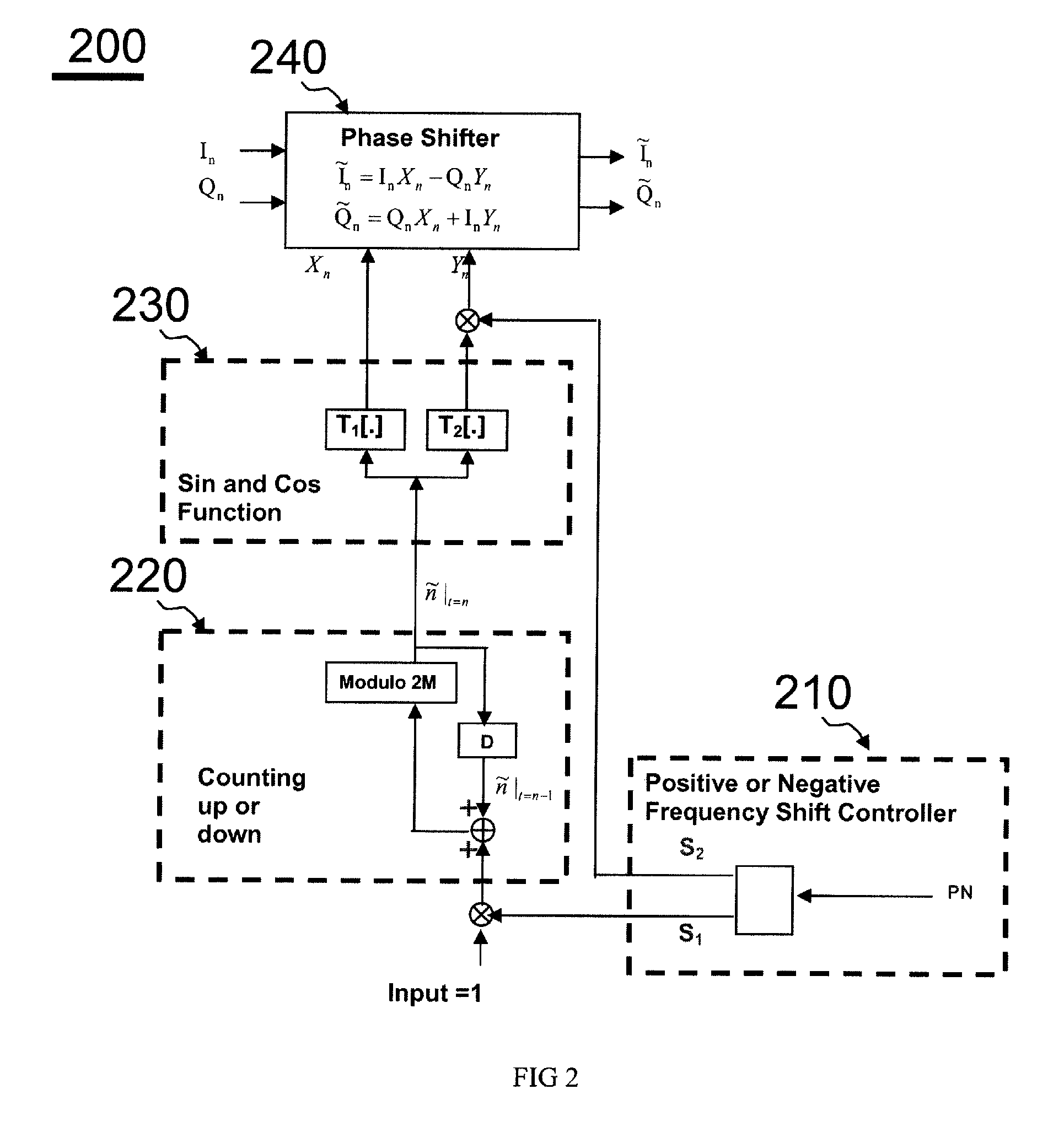Arbitrary frequency shifter in communication systems
a frequency shifter and communication system technology, applied in the field of frequency shifters, can solve the problems of accumulated phase error f/sub>times added, and achieve the effect of simple implementation
- Summary
- Abstract
- Description
- Claims
- Application Information
AI Technical Summary
Benefits of technology
Problems solved by technology
Method used
Image
Examples
example 2
A TYPE B Implementation
[0082]fs=7MHz,ϕ=2π(fΔfs)=2π(±7N±1.57π)=(±14N±37π),
where frequency shift fΔ=(±7N±1.5) MHz and
N is an arbitrary positive integer. Obviously, K=3 and M=7 in this example.
The reference time index is found as follows:
[0083] n~t=n={ n~t=n-1+S1-14,if n~t=n-1+S1≥14 n~t=n-1+S1+14,if n~t=n-1+S1<0 n~t=n-1+S1,otherwise.
where S1=1 or S1=−1 if counting up or counting down is required, respectively.
In short, a modulo 2Kπ (or 6π) operation is equivalent to a modulo 2M (or 14) operation.
The required two LUT are found as follows:
[0084]T1[m]=cos(mKπM)=cos(m3π7),m=0,1,2,…,13.T2[m]=sin(mKπM)=sin(m3π7),m=0,1,2,…,13.(EQ-23)
[0085]And the required cos and sin function values to calculate (EQ-3) or (EQ-4) are shown as follows.
cos θn=T1[ñ] and sin θn=T2[ñ], ∀n.
[0086]The size of the required LUT is 4M=28 entries. In this example, the two LUTs are specially designed for a particular K=3 only. If another desired frequency shift (i.e., a different K) is...
example 3
An Implementation of TYPE C1 Frequency Shifter 300 of the Present Invention with R=1
[0088]fs=7MHz,ϕ=2π(fΔfs)=2π(±7N±K×0.57π)=(±14N±K7π),(EQ-24)
where arbitrary fΔ=(±7N±K×0.5)={circumflex over (K)}×0.5=0, ±0.5, ±1, ±1.5, ±2, ±2.5, . . . , MHz,
N is an arbitrary positive integer, K is an arbitrary integer between 0 and 13, and {circumflex over (K)} is an arbitrary integer (from the smallest integer to the largest one in theory). Obviously, R=1 and M=7 in this example. In short, by controlling integer K from 0 to 13, an arbitrary frequency shift which is an integer multiple of 0.5 MHz can be achieved. The reference time index is found as follows:
[0089] n~t=n={ n~t=n-1+S1×K-14,if n~t=n-1+S1×K≥14 n~t=n-1+S1×K+14,if n~t=n-1+S1×K<0 n~t=n-1+S1×K,otherwise.(EQ-25)
where S1=1 or S1=−1 if counting up or counting down is required, respectively.
In short, a modulo 2π operation is equivalent to a modulo 2RM (or 14) operation. The required one LUT is found as follows:
[0090]T3[m]...
example 4
An Implementation of TYPE C2 Frequency Shifter 300 of the Present Invention with R=2
[0092]fs=14MHz,ϕ=2π(fΔfs)=2π(±14N±K×0.514π)=(±28N±K2×7π),(EQ-28)
where arbitrary fΔ=(±28N±K×0.5)={circumflex over (K)}×0.5=0, ±0.5, ±1, ±1.5, ±2, ±2.5, . . . , MHz
N is an arbitrary positive integer, K is an arbitrary integer between 0 and 27, and {circumflex over (K)} is an arbitrary integer. Obviously, R=2 and M=7 in this example. In short, by controlling integer K from 0 to 27, an arbitrary frequency shift which is an integer multiple of 0.5 MHz. The reference time index is found as follows:
[0093] n~t=n={ n~t=n-1+S1×K-28,if n~t=n-1+S1×K≥28 n~t=n-1+S1×K+28,if n~t=n-1+S1×K<0 n~t=n-1+S1×K,otherwise.(EQ-29)
where S1=1 or S1=−1 if counting up or counting down is required, respectively.
In short, a modulo 2π operation is equivalent to a modulo 2RM (or 28) operation. The required one LUT is the same as (EQ-26):
[0094]T3[m]=sin(mπ2×7)=sin(mπ14),m=0,1,2,…7.(EQ-30)
And the required...
PUM
 Login to View More
Login to View More Abstract
Description
Claims
Application Information
 Login to View More
Login to View More - R&D
- Intellectual Property
- Life Sciences
- Materials
- Tech Scout
- Unparalleled Data Quality
- Higher Quality Content
- 60% Fewer Hallucinations
Browse by: Latest US Patents, China's latest patents, Technical Efficacy Thesaurus, Application Domain, Technology Topic, Popular Technical Reports.
© 2025 PatSnap. All rights reserved.Legal|Privacy policy|Modern Slavery Act Transparency Statement|Sitemap|About US| Contact US: help@patsnap.com



